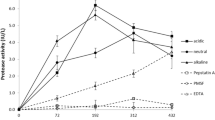Abstract
The white-rot fungus Trametes multicolor MB 49 has been identified as an excellent producer of the industrially important enzyme laccase. The formation of extracellular laccase could be considerably stimulated by the addition of Cu(II) to a simple, glycerol-based culture medium. In this study, optimal concentrations of copper were found to be 0.5–1 mM, which were added during the growth phase of the fungus. Other medium components important for laccase production are the carbon and nitrogen sources employed. When using an optimized medium containing glycerol (40 g/L), peptone from meat (15 g/L), and MgSO4·7H2O and stimulating enzyme formation by the addition of 1.0 mM Cu, maximal laccase activities obtained in shake-flask cultures were approx 85 U/mL. These results, however, could not be scaled up to a laboratory fermentor cultivation. Laccase production by T. multicolor decreased considerably when the fungus was grown in a stirred-tank reactor, presumably because of damage of the mycelia caused by shear stress and/or changes in the morphology of the fungus.
Similar content being viewed by others
References
Reinhammar, B. R. M. (1984), in Copper Proteins and Copper Enzymes, vol. 3, Lontie, R., ed., CRC Press, Boca Raton, FL, pp. 1–35.
Thurston, C. F. (1994), Microbiology 140, 19–26.
Eggert, C., Temp, U., and Eriksson, K.-E. L. (1996), ACS Symp. Ser. 655, 130–150.
Solomon, E. I., Sundaram, U. M., and Machonkin, T. E. (1996), Chem. Rev. 96, 2563–2605.
Mayer, A. M. and Harel, E. (1979), Phytochemistry 18, 193–215.
Mayer, A. M. (1987), Phytochemistry 26, 11–20.
Gianfreda, L., Xu, F., and Bollag, J.-M. (1999), Biorem. J. 3, 1–25.
Youn, H. -D., Hah, Y. C. and Kang, S. -O. (1995), FEMS Microbiol. Lett. 132, 183–188.
Henson, J. M., Butler, M. J., and Day, A. W. (1999), Ann. Rev. Phytopathol. 37, 447–471.
Wood, D. A. (1980), J. Gen. Microbiol. 117, 339–345.
Zhao, J. and Kwan, H. S. (1999), Appl. Environ. Microbiol. 65, 4908–4913.
Bar-Nun, N., Tal-Lev, A., Harel, E., and Mayer, A.M. (1988), Phytochemistry 27, 2505–2509.
Rigling, D. and van Alfen, N. K. (1993), Appl. Environ. Microbiol. 59, 3634–3636.
Bollag, J.-M. and Leonowicz, A. (1984), Appl. Environ. Microbiol. 48, 849–854.
Eggert, C., Temp, U., and Eriksson, K.-E. L. (1996), Appl. Environ. Microbiol. 62, 1151–1158.
Mansur, M., Suárez, T., and González, A. E. (1998), Appl. Environ. Microbiol. 64, 771–774.
Lee, I.-Y., Jung, K.-H., Lee, C.-H., and Park, Y.-H. (1999), Biotechnol. Lett. 21, 965–968.
Marbach, I., Harel, E., and Mayer, A.M. (1985), Phytochemistry 24, 2559–2561.
Ardon, O., Kerem, Z., and Hadar, Y. (1996), J. Biotechnol. 51, 201–207.
Crestini, C., D’Annibale, A., and Giovannozzi-Sermanni, G. (1996), Biotechnol. Tech. 10, 243–248.
Pointing, S. B., Jones, E. B. G., and Vrijmoed, L. L. P. (2000), Mycologia 92, 139–144.
Collins, P. J. and Dobson, A. D. (1997), Appl. Environ. Microbiol. 63, 3444–3450.
Palmieri, G., Giardina, P., Bianco, C., Fontanella, B., and Sannia, G. (2000), Appl. Environ. Microbiol. 66, 920–924.
Galhaup, C. and Haltrich, D. (2001), Appl. Microbiol. Biotechnol. 56, 225–232.
Cervantes, C. and Gutierrez-Corona, F. (1994), FEMS Microbiol. Rev. 14, 121–137.
Labbé, S. and Thiele, D. J. (1999), Trends Microbiol. 7, 500–505.
Xu, F. (1999), in Encyclopedia of Bioprocess Technology: Fermentation, Biocatalysis, and Bioseparation, vol. 3, Flickinger, M. C. and Drew, S. W., eds., John Wiley, NY, pp. 1545–1554.
Jönsson, L. J., Saloheimo, M., and Penttilä, M. (1997), Curr. Genet. 32, 425–430.
Bourbonnais, R. and Paice, M. G. (1990), FEBS Lett. 267, 99–102.
Hess, J. (2001), MS thesis, University of Agricultural Sciences, Vienna, Austria.
Buswell, J. A., Cai, Y. J., and Chang, S. -T. (1995), FEMS Microbiol. Lett. 128, 81–88.
Sethuraman, A., Akin, D. E., and Eriksson, K. E. (1999), Appl. Microbiol. Biotechnol. 52, 689–697.
Muñoz, C., Guillén, F., Martínez, A. T., and Martínez, M. J. (1997), Curr. Microbiol. 34, 1–5.
Sethuraman, A., Akin, D. E., Eisele, J. G., and Eriksson, K.-E. L. (1998), Can. J. Microbiol. 44, 872–885.
Vasconcelos, A. F. D., Barbosa, A. M., Dekker, R. F. H., Scarminio, I. S., and Rezende, M. I. (2000), Process Biochem. 35, 1131–1138.
Karahanian, E., Corsini, G., Lobos, S. and Vicuña, R. (1998), Biochim. Biophys. Acta 1443, 65–74.
Dittmer, J. K., Patel, N. J., Dhawale, S. W., and Dhawale, S. S. (1997), FEMS Microbiol. Lett. 149, 65–70.
Kirk, T. K. and Cullen, D. (1998), in Environmentally Friendly Technologies for the Pulp and Paper Industry, Young, R. A. and Akhtar, M., eds., Wiley, NY, pp. 273–307.
Kaal, E. E. J., Field, J. A., and Joyce, T. W. (1995), Bioresour. Technol. 53, 133–139.
Herpoël, I., Moukha, S., Lesage-Meessen, L., Sigoillot, J., and Asther, M. (2000), FEMS Microbiol. Lett. 183, 301–306.
Leitner, C., Haltrich, D., Nidetzky, B., Prillinger, H., and Kulbe, K. D. (1998), Appl. Biochem. Biotechnol. 70–72, 237–248.
Thomas, C. R. (1990), in Chemical Engineering Problems in Biotechnology, Winkler, M. A., ed., Elsevier Applied Science, London, pp. 23–93.
Braun, S. and Vecht-Lifshitz, S. E. (1991), Trends Biotechnol. 9, 63–68.
Baminger, U., Ludwig, R., Galhaup, C., Leitner, C., Kulbe, K. D., and Haltrich, D. (2001), J. Mol. Catal. B. Enzymatic 11, 541–550.
Author information
Authors and Affiliations
Corresponding author
Rights and permissions
About this article
Cite this article
Hess, J., Leitner, C., Galhaup, C. et al. Enhanced formation of extracellular laccase activity by the white-rot fungus Trametes multicolor . Appl Biochem Biotechnol 98, 229–241 (2002). https://doi.org/10.1385/ABAB:98-100:1-9:229
Issue Date:
DOI: https://doi.org/10.1385/ABAB:98-100:1-9:229




